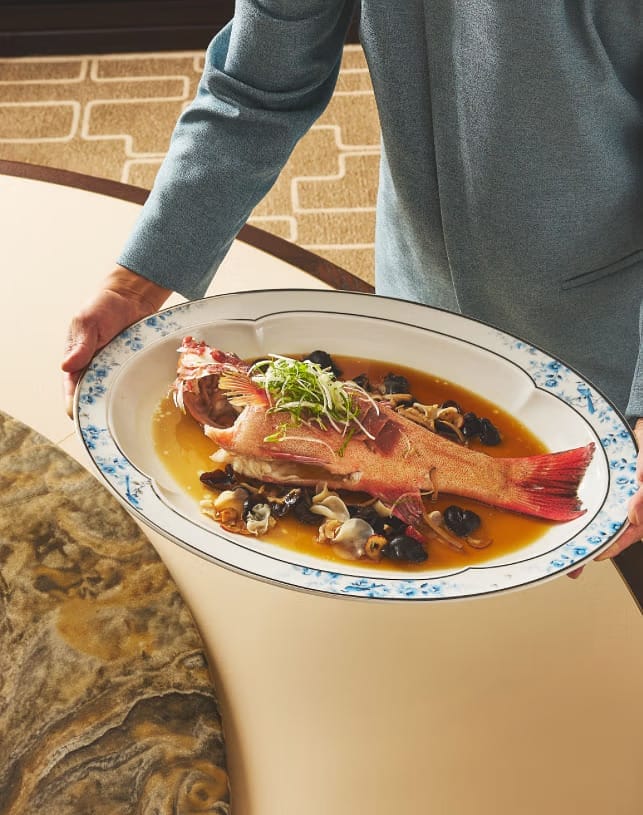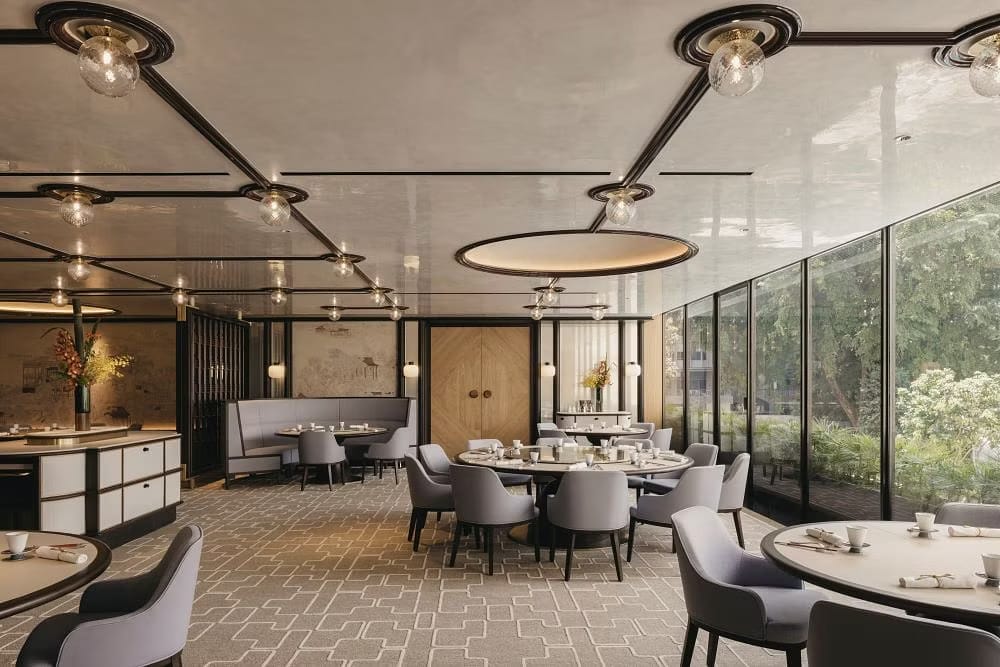by Tan Pin Yen

Photos: Summer Palace
The composition of a duo of black and white fungus, together with red dates and mushrooms on top of the steamed soon hock, might have seemed homely if not for that thinly sliced wind-cured three-year-old Yunnan ham. Fragrant and savoury, it accorded a layer of richness to the steamed dish and brought to mind a fading Cantonese classic — qi lin yu.
“If you had a lesser affinity with Cantonese cuisine, you might have missed this, it’s very subtle,” says Chinese executive chef Liu Ching Hai, who is trying to move Cantonese cuisine with time at one-Michelin-starred Summer Palace, which recently re-opened at the Conrad Singapore Orchard after a major revamp in late January.
A staple of expensive banquets in the 70s and 80s, Qi Lin Yu always features precious and expensive fish such as the dongxing grouper, which would be deboned and masterfully sliced into well-sized uniform pieces. Each slice of fish would then be arranged one by one with a piece of jin hua huo tui or cured ham and a piece of mushroom before being returned to construct the fish’s body along with its head and tail.

Cantonese cuisine, originating from Guangdong, emphasises freshness and preserving the natural flavour of food. (Photo: Summer Palace)
But as Liu would have it, the dish has found its way onto the menu and is served in a warm classy vessel from Legle’s signature Ruyi Platinum Rim collection with just a hint of its glory and former splendour.
A new chapter for Summer Palace
As far back as recollections go, Summer Palace, inspired by its namesake in Beijing, looked every bit the gracious dame she is. The restaurant, which has aged particularly well, served its last group of diners in last July before shutting down for about six months for renovations as part of Conrad Singapore Orchard’s comprehensive restoration. The restaurant re-opened in late January alongside the hotel’s 445 newly constructed guest rooms.
More than a nip here and a tuck there, Matthew Shang Design Office, the same design team that developed the hotel’s Manhattan Bar — which is also on the list of the World’s Best 50 Bars — completely transformed the space.

At the new Summer Palace, the design ethos is characterised by soft green hues and shade trees, creating a tranquil garden atmosphere and fusing ancient Chinese aesthetics with modernist design principles. (Photo: Summer Palace)
In the main dining room, wood panels that lined the walls have retired, as have the red carpets, aged wooden chairs with spokes and accompanying red cushions. The walls now sport hand-painted murals by De Gournay depicting halls, long corridors, and landscaped Chinese gardens in a palace.
Tastefully highlighted in aubergine, taupe, and lilac, the feature walls complement a quiet blend of earthy colours and a pretty neutral seafoam blue, echoed in the chairs and uniforms of wait staff.
Private recesses feature strongly in this reconstrued space, and the upholstered banquette seating — set to be booked out fast — aims to work modern sensibilities into the tradition of communal Chinese dining. At the sides are two well-proportioned private dining rooms, one decorated in a richer empire blue and the other featuring a muted colour palette of ivory and other natural tones.

Natural tones bring warmth, evoking a sense of quiet luxury. (Photo: Summer Palace)
The peach-coloured tablecloths are long gone, as are the square and rectangular bone china plates with cut straight lines. The look is complete with a marble lazy Susan centrepiece and elegant dinnerware from Legle’s Ruyi collection.
Instead of the Chinese soup spoon, the Robert Welch metal soup spoon comes off as a pleasant surprise and is paired with chilli red Christofle chopsticks from the brand’s Uni line. The napkin, tilted at 45 degrees, is neatly secured with a gold-plated ribbon ring.
Summer Palace’s 40-year-in-the-making update also installed a tea bar at the right entrance of the restaurant. Featuring a curated selection of 32 artisanal black, green, white, and flower teas in seafoam blue tin cans, the stage is set for a ritual of Chinese tea ceremony or inventive craft tea-inspired cocktails.
The latter cocktail program is led by renowned bar personality and Conrad Singapore Orchard’s beverage director, Rusty Cerven. Meanwhile, a wine list put together by Park90 delights wine enthusiasts and a sommelier service promises more indulgence when world-class wines meet serious Cantonese fare.“ Extensive work has also been done on the menu; as much as 50 per cent of the menu has been recalibrated,” Liu adds.

Elegant porcelain from LEGLE’s RUYI collection featuring rounded corners, fluid curves and clean lines. (Photo: Summer Palace)
Spotlight on simplicity
One of the longest-serving executive chefs in a Chinese restaurant in Singapore, Liu has been at the helm of Summer Palace’s kitchen since 2009.
“My approach to cuisine has evolved through time, focusing on deliberate simplicity. Clean or healthier cooking methods have been adopted to meet seasonality and showcase healing foods. We have yin and yang double-boiled soups designed to feed the body, such as the chen yu luo yan (yin). The menu has become more concise; some items were tweaked, for example, a classic dish of sweet and sour pork now features pomegranate seeds instead of pineapple. Stir-fried wagyu slices are now poached in a hot and sour broth.”
His secret lies in keeping food warm
Regulars have already been returning for specialties like roast meats, Cantonese stir fries including wok-fried crocodile meat with spice sauce, and his signature double-boiled sea treasure soup served in a pumpkin.
“As far as possible, we would prepare dishes upon request, even if they are not on the menu. I want diners to walk away feeling satisfied,” he continues.
This fleeting moment of satisfaction, or bliss, is a quality he has come to attach great significance to. “When I was a child, my grandma made congee for me. The warmth that strikes you right in the heart makes you feel reinvigorated. This is what I’m after — more than the stars.” He grinned.
Liu says the secret to achieving that is optimal temperature.
In Cantonese, he shares, “Yi re zhe bai chou, or just heat, and heat alone can conceal all other shortcomings. Someone I used to work for always kept his food warm. Over the years, I saw the wisdom in his words.”
It is no wonder he has an assortment of claypot dishes and plate warmers installed even in the dining room, concealed as pretty service stations between tables.

On the left, the Yang soup, which contains maca, cordyceps, venison tendons, sea cucumber, and abalone, promotes vigour. The Yin soup is a nourishing bird’s nest broth with ingredients such as fish maw, sea whelk, dried scallops, ginseng, red dates, longan, and wolfberries. (Photo: Summer Palace)
“I am extremely particular regarding temperature management because this would affect the flavour, fragrance, and ultimately, how enjoyable a dish is. To be honest, I would much prefer to have diners wait slightly for a dish to be served hot than to have it cold on the table.”
Even his fried rice dishes are served in claypots to retain the heat.
Keeping Cantonese classics alive
“I think that wok-fried dishes are a hallmark of Cantonese cooking. As a chef, I have been trained to respect the best moment in cooking. Hours have been spent practising at the wok station to master a fire — to capture the wok’s breath. To cook for any longer than that precise instant, we would be berated.”
He expects seasoning to be achieved instantly in his kitchen, but it requires years of training and impeccable judgement to accomplish.
“If seasoning can only be achieved after two tries, the dish would probably have been overcooked,” he explains.
His culinary philosophy and efforts to uphold the fundamental tenets of cooking may have stemmed from his training under great masters such as Fo shan-born chef Fok Wing Tin, who made a name for himself at the Empress Room in Raffles Hotel, and Peter Tsang, who has worked at well-known establishments such as Yung Kee Restaurant, Lei Garden, and Crystal Jade Group.

Plate warmers are cleverly designated in service stations in the dining room. (Photo: Summer Palace)
“What is has to be; nothing should be added without a cause. Colour (色), fragrance/aroma (香), and flavour (味) — many before me have devoted their life to perfecting what may seem like simple concepts to grasp. Having the expertise to work with ingredients across the seasons is essential,” says Liu, who arrived in Singapore in 1993 and honed his skills at Tung Lok Group’s first haute Cantonese restaurant in Liang Court before moving on to fine-dining Chinese restaurants in Bangkok, Jakarta, and Kuala Lumpur as executive Chinese chef of the Shangri-La Hotel Group.
Marking 40 years in the dining industry next year
When asked if he will be aiming for two stars, the youthful-looking chef, who is 57 this year, responds simply, “We first take care of the work we do on an everyday basis, and the rest will take care of themselves.”
Summer Palace was awarded a Michelin star in the Michelin Guide Singapore 2017, a distinction it has held ever since. Looking forward to commemorating his 40th year in the industry next year, chef Liu recalls his fascination with the operations of a restaurant kitchen as a teen: “Live fish in tanks, how chefs handled ingredients, the roar of the woks. The kitchen was so busy, but it felt like everyone was committed, motivated, and happy. I liked that feeling, and that was how I found my way into the kitchen.”
It was then that he discovered classics such as Qi Lin Yu and learned that a dish had as many stories as stages to perfection.
“These stories piqued my interest: why do some dishes have these names, and why must certain techniques be employed? Even now, the learning never stops, which keeps me motivated and young.”
When the restaurant was being renovated, chef Liu spent two months in Kunming, Yunnan, Beijing, Shanghai, Hangzhou, and Hong Kong, visiting sturgeon farms and tea plantations and dining at Michelin-starred restaurants.
But everywhere he went, it brought him closer to Summer Palace.
“Before we closed for renovation, so many regulars came in for a meal and the restaurant was so booked out even our owners had difficulty getting a table. This show of support really warmed my heart, so there’s lots of catching up to do now. In my mind’s eye, I can see this space shine, and right now, I simply cannot wait to see this happen.”

